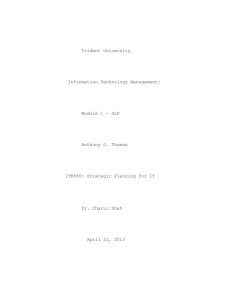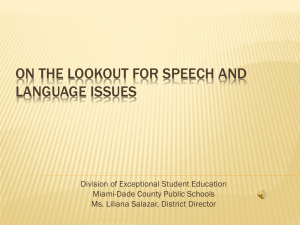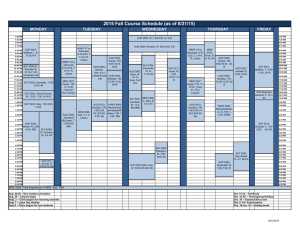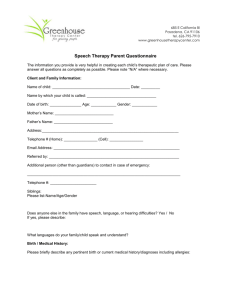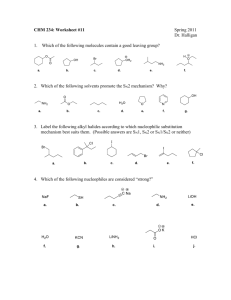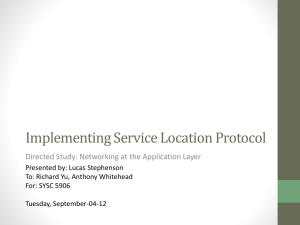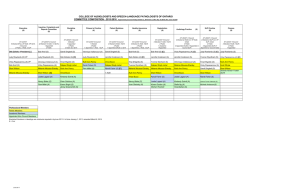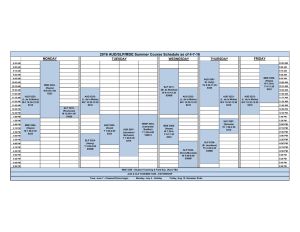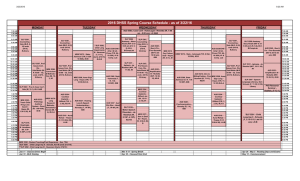A Capstone Course in SLP Preparing Millennials for Success
advertisement
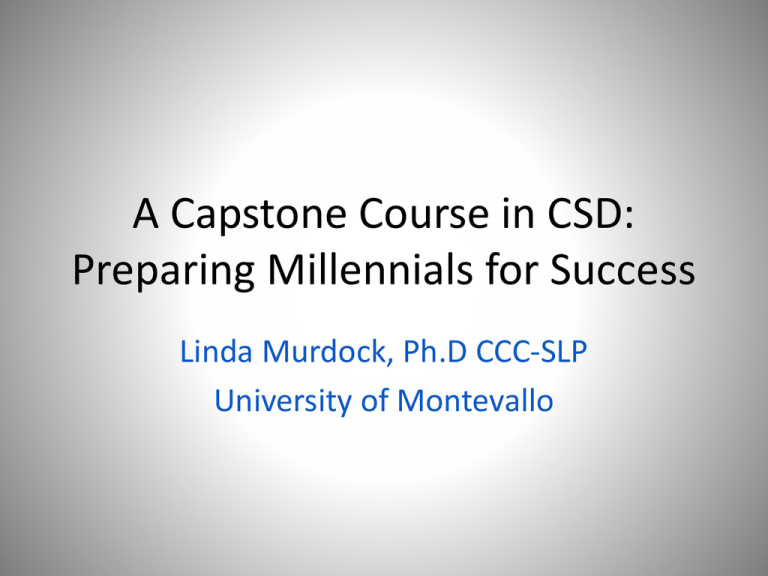
A Capstone Course in CSD: Preparing Millennials for Success Linda Murdock, Ph.D CCC-SLP University of Montevallo What should a capstone course do? • Help students see the connection between the courses; integrate the information • Should be a unique learning experience • Should be student-centered or studentdirected • Should require command, analysis, and synthesis of material • Should help prepare students for the next step Our department needed to create a capstone course for our Seniors that would bridge the gap between the undergraduate and graduate experiences. Passive Learner Active, Lifelong Learner Goal is to make a good grade Goal is to learn what I need to know to be a good SLP/AUD Professor is responsible I am responsible for learning. I take ownership of the process I learn about disorders I help people Four Components 1. Knowledge of Self Learn the skills and attributes that you have to offer and that you can use to excel. Discover areas for growth. 2. Counseling An overarching skill to be used across disorders and across the lifespan. Ties the courses together. 3. Bridge to Practice Beginning to see themselves as SLPs or AuDs 4. Knowledge of the Profession Move away from textbook knowledge toward knowledge held by practicing SLPs/AuDs Day 1 • You are an employee in CSD 464 • Attendance Policy: • Because professionalism is a core concept in this course, students are expected to approach this course like they would a job. It is not acceptable to be late or to skip class without a University approved excuse. Two unexcused absences will be allowed without penalty. Beginning with the third unexcused absences, 5 points will be taken off the student’s final grade for each absence. • Chronic tardiness will not be tolerated. Beginning with the fourth late arrival, students will lose 5 points from their final grade for each late arrival. • These points are off the final grade, not the points total for the class. For example, a student with a 93 average, with 3 unexcused absences will have an 88 as the final grade in the class. Course Requirements • Journal entries -10-15 as assigned. Approximately 8-10 will be evaluated with a rubric for 10 points each and the remaining entries will receive up to 5 participation points for being on time and complete. • Class Participation- Each student will be evaluated three times (12 pts each) during the term for class participation with a rubric provided to students. These evaluations are conducted at random and if a student is absent without excuse on the day they are conducted they will receive a zero. • Leading a Discussion- each student or team of two students will put together readings on an issue facing the profession. They will identify 5 discussion points/questions and lead a 20 minute discussion on the topic. 50 points • Shadowing an SLP- Students will shadow an SLP/AuD for 5 hours and write a reflection: 50 points. Students will schedule their own observations of a CCC-SLP. Students are expected to show professionalism in scheduling and observing. Grade penalties will be imposed for unprofessional behavior. • Attend a CEU event 1. Knowledge of Self Purposes • Purposes: 1. Describe the characteristics of people from different generations: Baby Boomers, Gen X’ers, Millennials. Understand how we form expectations and judgments based on these traits. 2. Identify Helicopter Parenting and how it can be problematic in adult life. 3. Understand why constructive criticism is necessary and why Millennials may not have practice accepting it gracefully. 4. Describe how multitasking is perceived by other generations. Student Reflection • “I’m so glad you chose this book for us to read. I have never really sat down and thought about how my generation is perceived. I found the book to be very insightful. I did get quite offended by some of the things I read, but it’s only because most of it was true and I just did not want to hear it.” Student Journal Entry • “I think these people hit the nail on the head about my generation. I agree with the negative and positive characteristics these people believe about us. We are ambitious, tech savvy, team players, accepting of others, optimistic. We care about environmental issues and politics, and we value relationships. However, we are praise seekers, job-hoppers, impatient, self-absorbed, immoral, in need of guidance, and have no common sense.” Student Journal Entry • “I like that this book offers insight into how my generation views the world and some of our traits. Some of these traits are good and some are bad but I think it’s important to learn abut all of them and check yourself for these mindsets….It has already caused me to view situations differently and step back and ask myself if this is a millennial request or a request that is really appropriate.” How does this help them? • Awareness that expectations are different and sometimes we have to code-switch BEHAVIORS. • Awareness that some of their behaviors might be perceived as negative or offensive • Awareness that others may have opinions about Millennials that they may need to refute if they want certain opportunities. – E.g. “I’ll never hire someone from this generation again.” 2. Counseling Additional Content • Students also completed self-assessment surveys to learn their positive and negative character traits and to identify what makes them happy in life. These are activities they can do with clients facing grief or adversity. Purposes 1. 2. 3. 4. Develop empathy. Think about the clients as people, not just disorders. Develop interpersonal communication skills. Learn how to help clients approach life from a wellness perspective. Learn to see what’s right instead of what’s wrong. Learn counseling techniques and how to react during emotional moments. Student Reflections • “I think if I had not realized the importance of more than one expert, I would have lacked many of the necessary skills for counseling. It’s not that I don’t posses these skills, rather I feel as though I would have been too caught up in knowing everything, being right, and having all the answers, that compassion, empathy, and listening would have been lacking in my approach with clients and their families.” Student Reflections • “Families are not going to have an easy time accepting a diagnosis and this is where our counseling skills come in. This book was full of useful tips and things I had never thought about having to do with families.” • “ In the whirlwind of taking all of these courses, I wasn’t conscious of the fact that these people have feelings and emotions, and some have just gone through something tragic. This class gave me the confidence to be able to work with these people and feel like I have something to offer them.” 3. Bridge to Practice • Purposes: • Begin to think of yourself as an employee and practicing SLP/AUD rather than a student. • Determine your conflict style and learn skills for handling conflict and advocating in the workplace. 3. Bridge to Practice • 1. Conflict Resolution • McShane, S. L., & Von Glinow, M. A. (2003). Organizational Conflict and Negotiation. In Organizational behavior: Emerging realities for the workplace revolution (pp.384-413). New York, NY: McGraw-Hill Irwin. • 2. Shadow an SLP or AuD 5 hours • 3. Attend a CEU event for 4.0 hours or complete a professional advocacy project such as a letter writing campaign Journal Entry • “Sometimes [with conflict] I either get defensive too quickly or back off when I feel threatened by someone, especially a supervisor or other adult with more experience than I have. I hope to focus more on collaborating with all parties and end up in more win-win situations. I feel that I have walked away from this assignment with a better understanding of myself in conflict situations and how to better handle them in the future.” Student Reflection • This section [of the course] has taught me the differences in conflict management styles so that I can properly identify my tendencies in conflict resolution and pinpoint the areas that need work. Having these understandings will be a huge advantage as I finish my education and as I move forward as a professional and as a person.” Student Reflections • “I’m so glad we were able to do this shadowing experience. It was much different than watching videos or watching therapy through clinic windows.” • “ This class rejuvenated my spirit and brought back my excitement about being an SLP. I loved the opportunity to do live observations outside the UM clinic because it gave us a glimpse of what the future may hold. This has been one of the most different and interesting classes I’ve taken as a CSD major, but overall everything about the way this class was designed has been beneficial in so many ways. “ 4. Knowledge of the Profession • Purpose: To move away from textbook knowledge into the issues of the profession • Teams of two identified articles (ASHA Leader) regarding issues facing the profession. Teams assembled a reading list and 5-6 questions or talking points for class discussion. Teams led one class meeting: 20 minutes for students to read the materials and 30 minutes for discussion. Classmates were assessed with a participation rubric. Topics – Caseload Size – Diversity in the Profession – Bilingual Services – Caps on Medicare/Reimbursement – Lack of PhDs – Supervision of SLP Assistants – Telepractice and Distance Education – Specialty Certifications – Lack of EBP – Shortage of Graduate Programs – Productivity Requirements 3 2 1 0 Attention Score ___ Actively supports, engages and listens to peers Listens to peers Limited interaction. Distracted by devices/internet/other mtrls Disconnected-virtually no interaction with peers. Multiple instances of distraction Comprehension Of Material Score ___ Comments advance the level and depth of the dialogue Makes relevant comments based on the assigned material (without being called upon) Comments are generally vague or drawn from outside the assigned material Demonstrates a noticeable lack of interest in the material Participation Score___ Group dynamic & level of discussion were significantly better because of the student’s contribution Student participated in a meaningful way Participation was at a surface level Group dynamic and level of discussion are harmed by the student’s contribution or student did not contribute Professionalism & Preparation Score ____ Arrives on time & fully prepared On time & demonstrated some preparation Late and/or did not demonstrate preparation Lack of professionalism negatively impacted the group Student Reflections • “Doing these readings and discussions really opened my eyes up to so many different issues we will have to face in our profession.” • “The discussion groups were very enlightening. It empowered us as students to lead discussions that were engaging and to understand the issues we will soon be facing as professionals.” Remember the goals we set for the course? Passive Learner Active, Lifelong Learner Goal is to make a good grade Goal is to learn what I need to know to be a good SLP/AUD Professor is responsible I am responsible for learning. I take ownership of the process I learn about disorders I help people 1. Move from a passive to an active, lifelong learner • “I love the creative way the class was set up, and it made me really excited about learning.” • “I appreciated the opportunity to contribute my thoughts.” 2. Become responsible for learning. Take ownership of the process • “I liked the way it felt like we were teaching one another rather than being taught by the professor.” • “I used to question the preparedness of my professors….then…I realized I HAVE TO GO TO GRAD SCHOOL SOON. They are not going to hold my hand and give me study guides and all that junk. They may not tell us EXACTLY what is going to be on the test. I have to rely on myself.” 3. Goal is to learn what I need to know to be a good SLP/AUD • “This course has prepared me to be a successful graduate student and future SLP better than any other course I’ve had a UM. Of course it didn’t teach me a ton of new “textbook information” but it has instead given me stronger professional skills, advice on handling interpersonal issues, a better sense of how to deal with conflict in a mature and efficient manner, a somewhat painful (yet much-needed) understanding of how our future employers may be predisposed to view members of our generation, and a wonderful, deeper bond with every member of our classroom.” 4. Develop the mindset that I treat people, not disorders • “I learned that we should always put the patient first and that the most important thing is to see them as people first, not just patients.” Ready for the next step… • “Before this course I was afraid to let anyone know how I was truly feeling or share my opinion. I always made sure I pleased the other person. Now I know how much that was holding me back and how much it could potentially hold back my future clients. For the fist time ever, I feel like I can actually go to graduate school and feel like I belong.” Questions? • murdocklc@montevallo.edu
